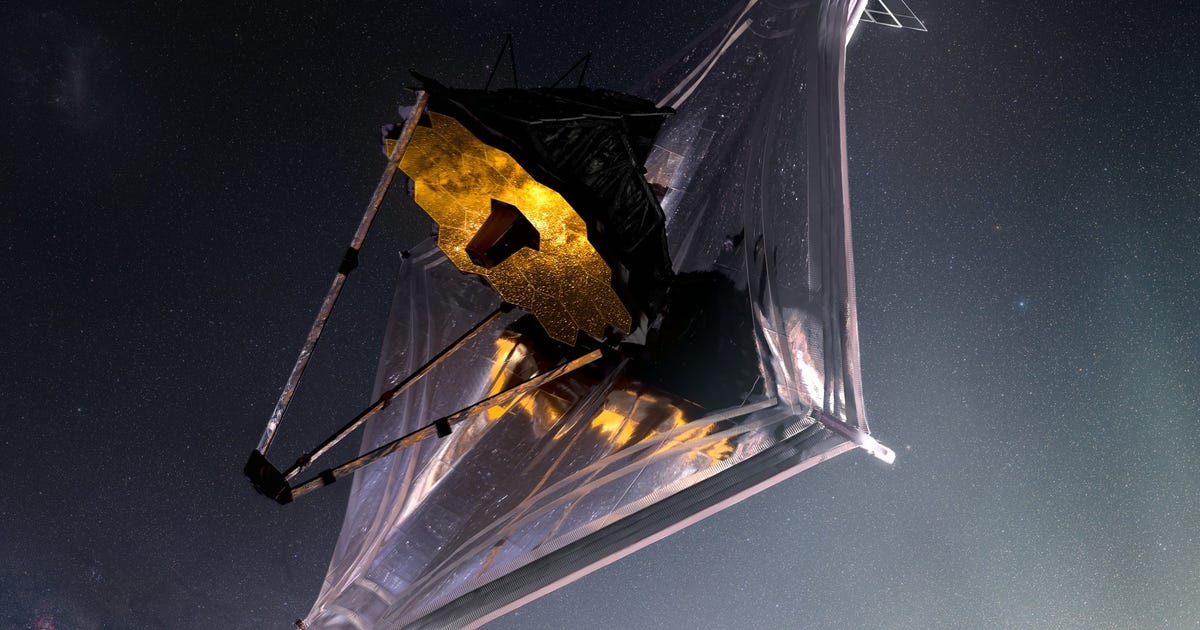
This story is part of Welcome to Mars, our series exploring the red planet.
We have a standard vision of what Mars looks like as a reddish, rocky planet, like in this Hubble image. The James Webb Space Telescope, however, sees the universe in infrared. Its first observations of Mars show how it’ll be able to investigate the red planet in exciting new ways.
Mars in infrared
JWST is built to gaze deep into the universe, using infrared to penetrate dust and see objects that hide from other telescopes. But it’s also useful for learning more about our planetary neighbors. On Sept. 5, Webb looked at Mars and gathered data with its Near-Infrared Camera, aka NIRCam.
Webb was able to see the side of Mars that was facing the telescope, called the observable disk. “As a result, Webb can capture images and spectra with the spectral resolution needed to study short-term phenomena like dust storms, weather patterns, seasonal changes, and, in a single observation, processes that occur at different times (daytime, sunset and nighttime) of a Martian day,” said NASA in a statement Monday.
The image of Mars on the left is a reference map. On the top right is Webb’s NIRCam image showing reflected sunlight with surface features labeled. On the bottom right is Webb’s view of emitted light showing temperature differences with latitude and time of day. Hellas Basin appears darker due to atmospheric effects.
NASA/ESA/CSA/STScI and Mars JWST/GTO team
NASA released a graphic showing what Webb could see in two different wavelengths of infrared light. It brings home Webb’s versatility and shows how shorter and longer infrared wavelengths can generate different sets of data. Here’s a crash course in how Webb’s infrared imaging works.
The brownish view of Mars on the left is a reference map. Track over to the right for what Webb saw. The upper image is a shorter-wavelength (2.1 microns) view showing a chunk of the planet that includes the surface features of Huygens Crater, Hellas Basin and Syrtis Major, an area that appears as a dark spot in visible-light images.
The lower Webb image is like a “heat map.” This is what appears when Webb uses a longer-wavelength (4.3 microns) view. The brightest part is where the sun is overhead, warming that area. “The brightness decreases toward the polar regions, which receive less sunlight, and less light is emitted from the cooler northern hemisphere, which is experiencing winter at this time of year,” said NASA.
Look closer at that yellow-purple observation and you’ll see where NASA points out Hellas Basin, which appears darker than the surrounding area. So what’s going on there? It’s Mars’ atmosphere at work. Carbon dioxide molecules absorb some of the infrared light before it reaches Webb, giving the massive impact structure — a whopping 1,200 miles (2,000 kilometers) across — a darker hue.
“The Hellas Basin is a lower altitude, and thus experiences higher air pressure,” explained principal investigator Geronimo Villanueva. “That higher pressure leads to a suppression of the thermal emission at this particular wavelength range [4.1-4.4 microns] due to an effect called pressure broadening.”
Investigating Mars’ atmosphere
On top of all that NIRCam infrared goodness, Webb also used its Near-Infrared Spectrograph (NIRSpec) instrument to gather data on the water, carbon dioxide and carbon monoxide in the planet’s atmosphere. “Preliminary analysis of the spectrum shows a rich set of spectral features that contain information about dust, icy clouds, what kind of rocks are on the planet’s surface, and the composition of the atmosphere,” said NASA.
Webb’s Near-Infrared Spectrograph gathered data on the atmospheric composition of Mars.
NASA, ESA, CSA, STScI, Mars JWST/GTO team
Webb is jointly run by NASA, the European Space Agency and the Canadian Space Agency. NASA emphasized that the telescope’s Mars data is meant to highlight science in progress. Scientists are still analyzing the NIRSpec information to learn more about the red planet’s surface and atmosphere. The results will be written up in a study and submitted for peer review.
Mars was a challenging observation for Webb because the planet is so close that it runs the danger of “blinding” the telescope with its bright infrared light. The JWST team pulled it off by using short exposures and special data analysis techniques.
These early results show how Webb is more than a long-distance telescope. It promises to help scientists build a more complete picture of neighboring Mars.
James Webb Space Telescope Sees Mars in a New Light – CNET
Source: Media Star Philippines


0 Comments